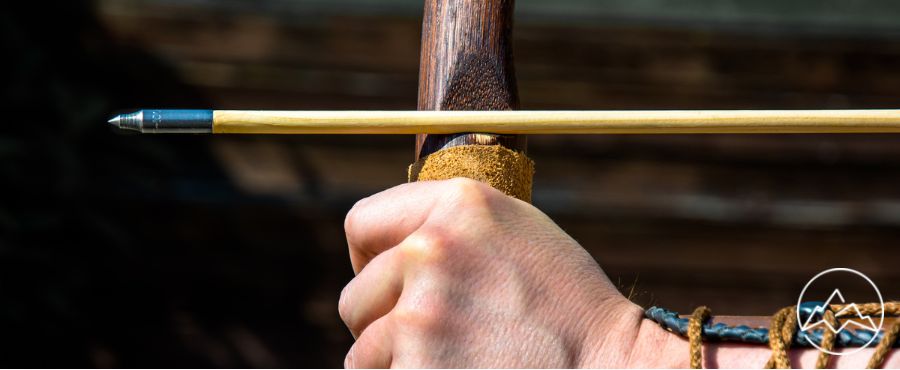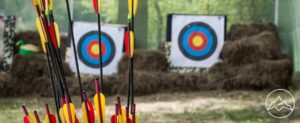Archery has grown in popularity over the last few years, and it’s often a sport requiring precision.
One of the ways you can improve your shot is by optimizing your arrows. There are many ways to do this, but more archers have considered the importance of the arrow’s F.O.C. or ‘front-of-center weight’. Some archers may make continual minor adjustments to improve their setup and overall performance, even in minute ways.The front of center weight measures how much of the weight is found in the front half of the arrow. But it’s not always clear how much of an impact this has. Is F.O.C. important, and what’s the ideal F.O.C.?
Those are the questions we’ll be exploring today before taking a look at how to calculate F.O.C.
How crucial is arrow F.O.C.?
F.O.C., or ‘front of center weight’, measures how much of the weight is concentrated in the front half. This is a natural consequence of the arrowhead being heavier than the rest of the arrow.
This balance point leans toward the front of the arrow (compared to the dead center of the shaft). Your arrow’s F.O.C. will affect how it performs and the trajectory. Archers debate exactly how much of an effect F.O.C. has on performance, but most professional archers indeed consider it carefully, and most archers at indoor tournaments will use a much higher F.O.C. than an outdoor shooter would. Bowhunters prefer to use an even higher F.O.C., as this helps the arrow penetrate the target better. This is particularly crucial if you hit a bone on impact.
Most experts and professional archers won’t fixate on the arrow’s F.O.C. too much. It does impact your performance, but it’s not the most important factor.
Several other factors include draw weight, length of your arrows, type of arrow, etc. These factors have a higher impact on arrow speed and performance.
Generally speaking, thanks to kinetic energy a lighter arrow will fly faster and further than a heavier arrow, and a higher draw weight will also help your arrow fly faster.
You should also carefully examine your arrow for any cracks, breaks, or signs of damage. Damaged fletchings can also harm arrow flight. But if you’re optimizing all areas of your arrow performance, the F.O.C. should be a part of that.
How is F.O.C. calculated?
There are a few ways to calculate F.O.C., the most straightforward formula may seem complex, but you’ll get the hang of it in no time. Begin by installing your components (broadheads/points, vanes, nock, inserts), etc. Once your arrow is set up, proceed to calculate:
- Measure the arrow’s overall length (distance to the bottom of the nock groove).
- Divide this by 2.
- Identify the balance point (where the arrow balances perfectly).
- Mark the balance point and measure from the throat of the nock.
- Subtract the center measurement (calculated in step 1) from the balance point (calculated in step 4).
- Multiply by 100.
- Divide the resulting number by the arrow shaft’s length. The result is the F.O.C. of your hunting arrow.
Some FOC calculators use this formula to help you deduce your arrow’s F.O.C.
If your arrow’s F.O.C. is deviant from the usual range of 10-15%, you can consider manipulating the F.O.C.
Manipulating F.O.C.
You can modify the arrow’s balance by adding weight to the front (or rear). Heavier vanes will decrease the F.O.C. by adding weight to the rear of the arrow. Replacing vanes with arrows can increase the F.O.C. You can add heavier points, inserts, and weights to increase the arrow’s weight (for lower or higher FOC.).
What is the ideal F.O.C.?
The best F.O.C. will depend on various factors. The environment you’re shooting in, the style of archery, and what you’re shooting will all have an impact.
As a general guide, if you’re shooting field points, you’ll probably want a F.O.C. between 8-11%. But if you’re hunting and using broadheads on a hunting arrow, you’ll want a heavier F.O.C. 12-15% is ideal for hunting. If you shoot with a shorter arrow, you’ll want a similar F.O.C.
Check out our review of the Best Recurve Bows
FAQs About FOC
What is FOC in archery?
How does FOC affect the trajectory of an arrow?
What factors determine a bow’s FOC rating?
Is there a formula for calculating FOC in archery?
How can adjusting the FOC on my bow affect accuracy and performance when shooting arrows at long distances?
Conclusion
Every archer will eventually try to improve their performance, and you can do this by optimizing your arrow. There are various ways to increase arrow speed and accuracy, including adjusting your draw weight, regular servicing of your equipment, and using lighter arrows. But you can also take your F.O.C. into account. The front of center weight measures how much weight is built up in the front of the arrow, which also has an effect on how your arrow flies. F.O.C. can be adjusted in several ways.
F.O.C. may seem complicated, but you shouldn’t overthink it. But you should maintain a balance carefully; a F.O.C. above 18-20% is unlikely to be effective for anything. If you have a high FOC, you risk creating too much drag. A point-heavy arrow won’t fly properly. Optimization is a good first step; if you’re not sure, steadily increase your F.O.C. but be sure not to go over 18%.











